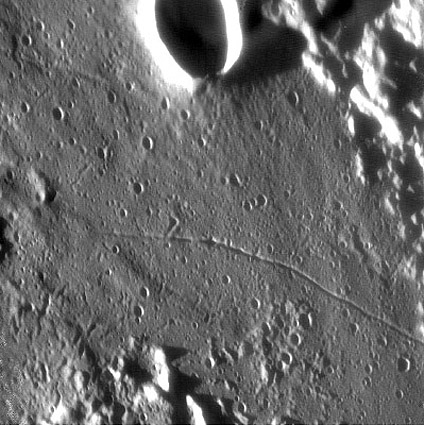In the past large telescopes were commonly used to image the Moon. Edward Holden used the 36" Lick refractor to compile a lunar photographic atlas in the 1890s and Moore and Chappell acquired more great images from 1937 to 1947. Pease used the Mt Wilson 100" reflector for a famous lunar series in the 1920s, and the Lick 120" made some memorable lunar images back in the early 1960s. The 61" Catalina reflector of the Lunar and Planetary Lab acquired thousands of images for the Consolidated Lunar Atlas of 1967. Since then the Moon has been infrequently imaged by large telescopes and when it happens, its a lark. A prime example is this wonderful view of a small area in the crater Taruntius in northern Mare Fecunditatis. The European Southern Observatory wanted to test its new 8.2 m (323"!) telescope with adaptive optics on an extended object (rather than a star), so it imaged this area. The resolution is 130 m, better than any other known terrestrial image of the Moon. I immediately contacted them suggesting more scientifically interesting targets for high resolution imaging, but never got a reply. I hope that some large telescope will again image the Moon (maybe with a webcam) and look at important sites - such as the locations of the Leonid flashes.
Technical Details:
30 April 2002, ESA VLT YEPUN 8.2 m telescope and NACO adaptive optics system, guided using a sunlit
lunar peak outside the field of view. A short exposure (0.22 seconds) through a narrow-band
near-infrared filter (at wavelength 2.3 m).
Related Links:
European Southern Observatory
ESO AIMS COUPLED OPTICAL TELESCOPES AT THE MOON>
|
Yanvar' Fevral' Mart Aprel' Mai Iyun' Iyul' Avgust Sentyabr' Oktyabr' Noyabr' Dekabr' |
|
Publikacii s klyuchevymi slovami:
Moon - Luna - Lunar Photo of the Day - LPOD
Publikacii so slovami: Moon - Luna - Lunar Photo of the Day - LPOD | |
Sm. takzhe:
Vse publikacii na tu zhe temu >> | |
